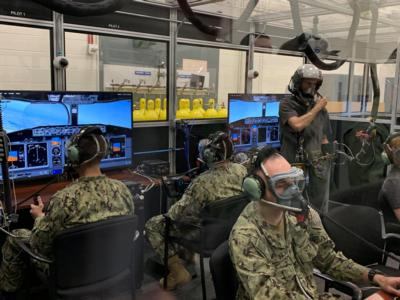Thu, Jun 10, 2021
Former Methods Often Caused Decompression And Barotrauma Sickness
The Naval Aviation Training Systems and Ranges program office (PMA-205) Normobaric Hypoxia Trainer (NHT) team recently designed, delivered, installed, and began support of the NHT at Naval Air Station (NAS) Patuxent River, the first trainer of its kind eliminating common hypoxia training injuries.

The legacy Low Pressure Chamber trainer used in hypoxia training for pilots and aircrew often caused decompression and barotrauma sickness, the leading causal factors for training injuries in the Naval Aviation Survival Training Program (NASTP). The NHT team, made up of an expert group of research engineers and scientists, looking to mitigate those injuries, developed the NHT concept.
“With the critical and innovative work of our NHT team, we no longer need to worry about barotrauma during cold and sinus season that caused trapped gas pain and injury in our fixed wing non-ejection seat aircrew students at the Aviation Survival Training Centers,” said Cmdr. Andy “Lurch” Hayes, NASTP integrated project team lead. “Inside safety observers no longer need to administer nasal decongestants or perform the invasive Politzer maneuver to inflate the middle ear and sinuses by injecting compressed air up one nostril while the other was closed.”
The NHT design not only eliminates the risk of barotrauma and decompression sickness, but it also can simulate high altitude flight while accommodating up to 12 personnel including six aircrew and two pilot/co-pilot teams monitored by two inside observers. Borrowed from the success of students trained on the Reduced Oxygen Breathing Device, the team included flight simulators and controls to add realism and allow aircrew to practice Emergency Procedures (EP) specific to their Naval Air Training and Operating Procedures Standardization aircraft. This is the first time in naval aviation history that fixed wing non-ejection seat pilots are able to practice EPs in a state of hypoxia.
“Gone are the days of patty cake in the chamber to monitor hypoxia symptoms. We are fortunate to have the aviation physiology expertise on our team that creatively developed a training system that allows the aircrew to experience hypoxia in a safe environment while conducting aviation operator tasks,” said Capt. Lisa Sullivan, PMA-205 program manager.
More News
Say Altitude Used by ATC to ascertain an aircraft's specific altitude/flight level. When the aircraft is climbing or descending, the pilot should state the indicated altitude round>[...]
Aero Linx: European Air Law Association (EALA) EALA was established in 1988 with the aim to promote the study of European air law and to provide an open forum for those with an int>[...]
From 2023 (YouTube Version): The Life, Death, Life, Death, and Life of a Glorious Warbird In 1981, business-owner Jim Tobul and his father purchased a Chance-Vought F4U Corsair. Mo>[...]
Also: USCG Retires MH-65 Dolphins, Irish Aviation Authority, NATCA Warns FAA, Diamond DA42 AD This summer, history enthusiasts will have a unique opportunity to experience World Wa>[...]
Also: WACO Kitchen Bails, French SportPlane Mfr to FL, Dynon-Advance Flight Systems, Innovation Preview Bobby Bailey, a bit of a fixture in sport aviation circles for his work with>[...]
 ANN's Daily Aero-Term (05.01.24): Say Altitude
ANN's Daily Aero-Term (05.01.24): Say Altitude ANN's Daily Aero-Linx (05.01.24)
ANN's Daily Aero-Linx (05.01.24) Classic Aero-TV: Korean War Hero Twice Reborn
Classic Aero-TV: Korean War Hero Twice Reborn Airborne 04.29.24: EAA B-25 Rides, Textron 2024, G700 Deliveries
Airborne 04.29.24: EAA B-25 Rides, Textron 2024, G700 Deliveries Airborne Affordable Flyers 05.02.24: Bobby Bailey, SPRG Report Cards, Skydive!
Airborne Affordable Flyers 05.02.24: Bobby Bailey, SPRG Report Cards, Skydive!



